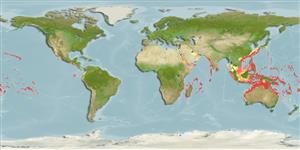Classification / Names
Common names from other countries
Main reference
Size / Weight / Age
Max length : 70.0 cm FL male/unsexed; (Ref. 9710); common length : 50.0 cm TL male/unsexed; (Ref. 3146)
Environment
Marine; reef-associated; depth range 1 - 180 m (Ref. 89972)
Climate / Range
Tropical; 26°C - 29°C (Ref. 27115), preferred 28°C (Ref. 107945); 35°N - 33°S
Distribution
Indo-Pacific: Red Sea and East Africa (Ref. 3145) to the Hawaiian, Marquesas and Tuamoto islands, north to southern Japan, south to Lord Howe and Rapa islands. Presence in Somalia to be confirmed (Ref. 30573).
Countries | FAO areas | Ecosystems | Occurrences | Introductions
Short description
Dorsal
spines
(total): 6;
Dorsal
soft rays
(total): 27-30;
Anal
spines: 2;
Anal
soft rays: 27 - 30. This species is characterized by the following: body depth 1.8 (in subadults) - 2.6 (adults) in SL; presence of a tapering body horn in adults projecting anteriorly at level of eye but not extending in front of mouth (horn first as a bump on forehead at a length of about 12 cm); dorsal profile from snout to horn straight, angle of about 45°; 2 peduncular plates with well-developed forward-curving knife-like spines; emarginate caudal fin when young, truncate with filamentous lobes in adult; olivaceous with blue peduncular plates and spines; dorsal and anal fins yellowish with narrow blue stripes (Ref. 27362).
IUCN Red List Status (Ref. 115185)
Threat to humans
Reports of ciguatera poisoning (Ref. 4795)
Human uses
Fisheries: commercial; gamefish: yes; aquarium: commercial
More information
ReferencesAquacultureAquaculture profileStrainsGeneticsAllele frequenciesHeritabilityDiseasesProcessingMass conversion
Tools
Special reports
Download XML
Internet sources
Estimates of some properties based on models
Phylogenetic diversity index
PD50 = 0.5000 many relatives (e.g. carps) 0.5 - 2.0 few relatives (e.g. lungfishes)
Trophic Level
2.2 ±0.11 se; Based on food items.
Resilience
Low, minimum population doubling time 4.5 - 14 years (K=0.14)
Vulnerability
Low to moderate vulnerability (32 of 100)
Price category
